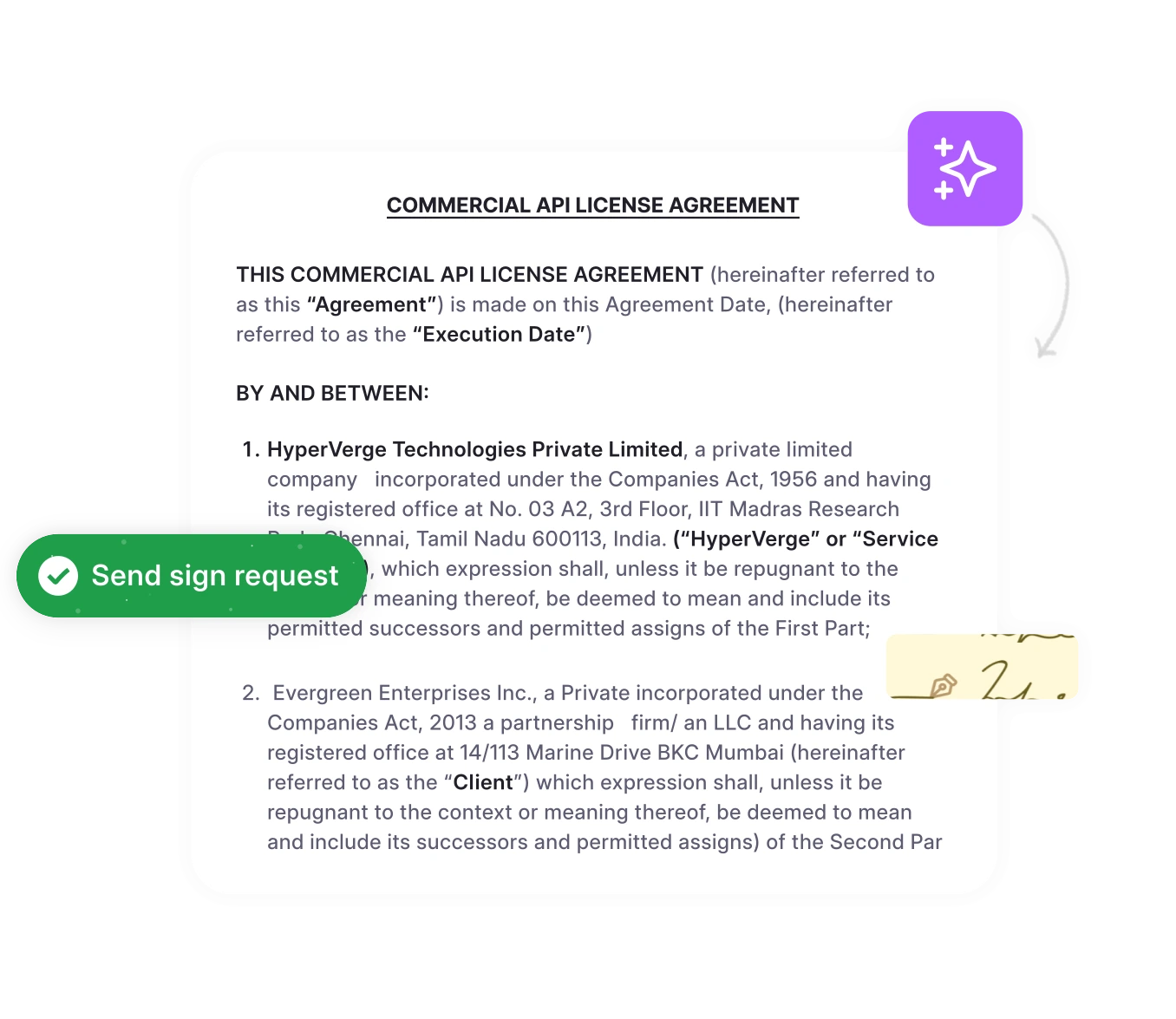Legal teams managing multiple cooperation agreements across departments face a familiar challenge: scattered contracts, missed obligations, and compliance risks that multiply with every new partnership. These multi-party agreements require sophisticated oversight, yet most organizations rely on manual tracking methods that create operational bottlenecks.
Cooperation agreements have evolved far beyond simple handshake deals. Today’s legal professionals must navigate complex commercial arrangements, strategic alliances, and joint ventures while ensuring every obligation is tracked and every contract renewal deadline is met. Here, effective contract management software becomes essential for organizations that handle multiple partnership agreements simultaneously.
This comprehensive guide transforms cooperation agreement chaos into organized operations, providing the legal framework and management strategies your team needs.
What is a cooperation agreement?
A cooperation agreement is a legally binding contract where two or more parties agree to work together toward shared objectives while maintaining their separate legal identities. Unlike merger agreements that combine entities, cooperation agreements create structured partnerships that leverage each party’s unique strengths, resources, or expertise.
Key legal characteristics that distinguish cooperation agreements:
| Cooperation Agreement | Other Contract Types |
| Multi-party collaboration framework | Bilateral service contracts |
| Shared objectives with individual accountability | Single-party performance obligations |
| Resource pooling arrangements | Asset transfer agreements |
| Ongoing partnership structure | One-time transaction focus |
| Joint decision-making processes | Unilateral control mechanisms |
The essential elements of a contract that make cooperation agreements enforceable include mutual consideration, a clearly defined scope of cooperation, and specific performance obligations for each party. Legal counsel must ensure these foundational components are appropriately structured to avoid disputes and enforcement challenges.
In a global framework, no organization can act efficiently on its own. Cooperation is necessary with other relevant institutions that can provide additional assistance or expertise. The legal basis for working together is defined in cooperation agreements.
Read
Understanding the meaning of cooperative agreement helps legal teams select appropriate management strategies for different partnership structures.
Eliminate contract chaos
Automate workflows from creation to compliance monitoring across all partnership types.
Book a Demo4 main types of cooperation agreements that legal teams manage
Legal departments encounter various cooperation agreement structures, each requiring different management approaches and compliance considerations. Understanding these types helps counsel select appropriate templates and risk management strategies.
1. Commercial cooperation agreement
Business cooperation agreements between companies focus on market expansion, product development, or resource sharing. These business agreements typically involve revenue sharing, joint marketing efforts, or technology licensing arrangements between two parties.
Common commercial cooperation structures include:
- Distribution partnerships with shared territories
- Technology licensing with development obligations
- Joint procurement agreements for cost savings
- Shared service arrangements for operational efficiency
2. Strategic alliance agreements
Strategic alliances create long-term cooperation agreements between two companies that complement each other’s capabilities. These partnerships often involve significant resource commitments and complex governance structures.
Partnership agreements in this category frequently include:Joint venture cooperation agreements
3. Joint venture cooperation agreements
Joint venture agreements represent the most complex form of cooperation, often creating separate legal entities while maintaining the underlying cooperative agreement structure between parent companies.
Legal considerations for joint ventures include:
- Capital contribution requirements and profit distribution
- Management structure and decision-making authority
- Intellectual property ownership and licensing terms
- Exit strategies and dissolution procedures
4. Research and development cooperation agreements
R&D cooperations involve shared research costs, intellectual property development, and technology transfer obligations. These cooperation contracts require careful IP protection and commercialization provisions.
The following comparison helps legal teams assess complexity and management requirements across cooperation types:
| Agreement Type | Key Risk Areas | Management Priority |
| Commercial Cooperation | Revenue allocation | Performance tracking |
| Strategic Alliance | Competitive conflicts | Governance oversight |
| Joint Venture | Legal entity compliance | Regulatory monitoring |
| R&D Cooperation | IP ownership disputes | Innovation milestone tracking |
Strategic cooperation agreements across all types require sophisticated legal oversight to ensure compliance with antitrust regulations, especially when involving competitors or market-dominant companies.
4 Key legal requirements in cooperation agreements
Effective cooperation agreement drafting requires specific clauses that address the unique challenges of multi-party collaboration. Legal counsel must ensure that these requirements protect the interests of each party while facilitating the successful execution of the partnership.
1. Scope definition and performance obligations
The foundation of any enforceable cooperation agreement starts with clearly defined contract clauses that establish the legal framework for collaboration.
Core provision requirements:
- Scope definition: Specific activities, territories, and timeframes covered
- Performance obligations: Measurable deliverables and timeline commitments
- Resource allocation: Financial, personnel, and asset contribution requirements
- Governance structure: Decision-making authority and conflict resolution processes
2. Risk allocation and liability requirements
Limitation of liability clauses become critical in cooperation agreements where multiple parties could cause damages or breach obligations.
Risk management essentials:
- Joint and several liability: Clearly define when parties share collective responsibility
- Indemnification obligations: Specify which party covers damages from specific activities
- Insurance requirements: Mandate appropriate coverage levels for high-risk activities
- Force majeure requirements: Address how external events affect cooperation obligations
3. Intellectual property and confidentiality terms
Cooperation agreement partnerships often involve sharing proprietary information, making confidentiality contracts and IP protection requirements essential.
IP protection framework:
- Background IP: Rights to pre-existing intellectual property remain unchanged
- Foreground IP: New developments during cooperation require ownership allocation
- Licensing terms: Usage rights for shared technologies or methodologies
- Publication restrictions: Control over public disclosure of cooperative activities
4. Termination and dispute resolution mechanisms
Contract termination provisions and arbitration clauses address the reality that not all cooperation agreements succeed as planned.
Legal protection checklist:
✓ Termination triggers: Material breach, failure to meet milestones, regulatory changes
✓ Notice requirements: Warning periods for termination or material changes
✓ Post-termination obligations: Ongoing confidentiality, IP licensing, and wind-down procedures
✓ Dispute escalation: Negotiation, mediation, and arbitration sequence requirements
✓ Governing law: Jurisdiction selection for enforcement and interpretation
Understanding these essential provisions provides the foundation for drafting practical cooperation agreements. The next step involves systematically structuring these elements into comprehensive, enforceable partnership frameworks.
How to structure effective cooperation agreements
Drafting cooperation agreements requires a systematic approach that addresses the complexities of multi-party collaboration while ensuring enforceability and operational clarity. Following these essential steps creates comprehensive cooperation frameworks.
Step 1: Define the cooperation scope and objectives
Begin with a precise definition of what the cooperation agreement will accomplish and the boundaries of the partnership. This foundational step prevents scope creep and clarifies expectations.
Scope definition requirements:
- Specific business activities covered by the cooperation
- Geographic territories and market segments included
- Timeline for cooperation phases and milestone deliverables
- Resource commitment levels from each participating party
Step 2: Establish a roles and responsibilities framework
Transparent allocation of responsibilities prevents disputes and ensures accountability. Each party must understand its specific obligations within the cooperative agreement structure.
Responsibility mapping essentials:
- Primary and secondary responsibilities for each party
- Performance standards and measurement criteria
- Reporting obligations and communication protocols
- Decision-making authority levels for different cooperation aspects
Step 3: Draft governance and decision-making processes
Multi-party cooperation necessitates structured governance to manage ongoing decisions and resolve conflicts that arise during the execution of the partnership.
Governance structure components:
- Management committee composition and authority
- Voting procedures for different decision categories
- Regular review meetings and reporting requirements
- Escalation procedures for deadlocked decisions
Step 4: Include risk allocation and liability provisions
Address the inherent risks of cooperation through comprehensive risk allocation that protects each party while enabling productive collaboration.
Risk management framework:
- Transparent liability allocation for different types of damages
- Insurance requirements appropriate to cooperation risks
- Indemnification procedures for third-party claims
- Limitation of liability caps where legally permissible
Step 5: Finalize termination and dispute resolution terms
Contract writing fundamentals require addressing the end of cooperation relationships through proper termination and dispute resolution provisions.
Legal protection mechanisms:
- Multiple termination triggers, including convenience and cause
- Wind-down procedures that protect all parties’ interests
- Post-termination obligations for ongoing confidentiality
- Dispute resolution procedures that preserve business relationships
Managing cooperation agreement compliance and obligations
Effective cooperation agreement management extends far beyond initial drafting and execution. Legal teams must implement systematic approaches to track obligations, monitor compliance, and ensure the success of partnerships.
Tracking cooperation agreement milestones
Multi-party agreements involve complex interdependencies, where one party’s performance affects the obligations of others. Tracking cooperation obligations requires sophisticated monitoring systems.
Milestone management essentials:
- Performance dashboards: Real-time visibility into each party’s progress
- Dependency mapping: Understanding how delays affect other parties’ obligations
- Milestone validation: Verification procedures for deliverable acceptance
- Exception reporting: Automated alerts for performance deviations
Automated obligation monitoring
Manual tracking of cooperation contract obligations creates risks of missed deadlines and compliance failures. Compliance monitoring systems provide the oversight legal teams need.
Automation benefits for legal operations:
- Obligation extraction from complex multi-party agreements
- Automated deadline tracking with escalating reminder sequences
- Performance metric calculation across multiple cooperation partners
- Compliance reporting for executive and regulatory requirements
- Centralized communication and decision tracking across organizations
Renewal and amendment management
Strategic cooperation agreements often include renewal options and amendment procedures that require proactive management. Renewal management prevents partnership disruptions and ensures continued value.
Successfully restructured joint ventures—excluding exit or termination—on average generate 10 to 30% improvements in financial and operating performance, demonstrating the value of active partnership management.
Read
Turn scattered obligations to organized workflows
Standardize obligation tracking, automate compliance monitoring, and eliminate version chaos.
Book a Demo4 common cooperation agreement challenges for legal teams
Legal departments managing cooperation agreement portfolios face recurring challenges that lead to operational inefficiencies and compliance risks. Understanding these challenges and their solutions enables better partnership outcomes.
1. Multi-party coordination complexity
Managing communications and decisions across multiple organizations creates coordination challenges that can derail cooperation initiatives.
Solution: Multi-party collaboration platforms provide centralized communication, decision tracking, and progress monitoring capabilities that streamline coordination across organizational boundaries.
2. Scattered agreement storage and tracking
Cooperation agreements stored across email systems, shared drives, and departmental databases create visibility gaps that prevent effective portfolio management.
Solution: Centralized contract repositories with AI-powered search capabilities enable instant access to any cooperation agreement, clause, or obligation across the entire legal portfolio, eliminating time wasted hunting for critical partnership documents.
3. Manual obligation monitoring risks
Tracking dozens of obligations across multiple cooperative agreements through spreadsheets and calendar reminders creates a high risk of missed deadlines and compliance failures.
According to the Ponemon Institute’s benchmark study of multinational organizations, the average cost of non-compliance is nearly $9.4 million, while the average price of compliance is $3.5 million, making non-compliance costs 2.65 times higher than investing in proper compliance activities.
Solution: Automated obligation tracking systems extract key dates, deliverables, and performance requirements from cooperation agreements, providing proactive alerts and compliance monitoring that prevents costly partnership disputes.
4. Renewal deadline management
Missing cooperation agreement renewal deadlines can terminate valuable partnerships and require expensive renegotiation processes.
Solution: AI-powered renewal management systems identify upcoming deadlines months in advance, track renewal decision progress, and ensure legal teams never miss critical partnership renewal opportunities that drive business value.
Streamline cooperation agreement management with HyperStart
Cooperation agreement management complexity demands sophisticated solutions that match the strategic importance of these multi-party partnerships. Legal teams cannot afford to rely on manual processes that create compliance risks and operational inefficiencies in today’s fast-paced business environment.
Modern legal operations require integrated platforms that transform chaotic cooperation agreements into organized operations. HyperStart- AI-powered contract lifecycle management software delivers the automation and intelligence legal teams need for effective partnership oversight.
Transform your cooperation agreement management with:
- AI-powered obligation extraction and monitoring across all cooperation types
- 2-7 day implementation versus months required by traditional solutions
- 80% faster processing for complex multi-party agreement reviews and renewals
- Automated renewal tracking that ensures you never miss critical partnership deadlines
- Centralized repository with instant search across entire cooperation agreement portfolios
Ready to eliminate cooperation agreement chaos? AI-powered contract management transforms legal operations from reactive firefighting to strategic partnership enablement.












